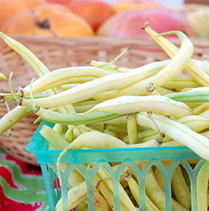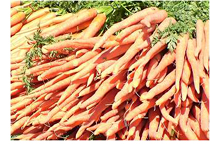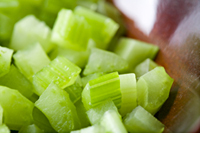
Super Kids Nutrition caught up with mom of young twins, writer and nationally recognized food expert based in Houston, Texas, Chris McCullum-Gómez, Ph.D., RD to hear her insights and knowledge on raising a healthy family, what is meant by “organic” and when to buy organic and local foods. For more information on What to Choose When Buying Organic, check out our previous post on the topic.
Quick and Easy Healthy Meals
Q: You are a busy working mom, with two young children. What are three quick and easy healthy meals that your family likes to eat?
I have numerous cookbooks that I use, which is where I find most of my quick meal ideas. A few examples include:
- Veggie pasta casserole served with a red lentil salad
- Sweet potato and black bean burritos served with brown rice, salsa, and a green salad; and
- Lemony zucchini and basil quinoa pilaf with chicken served with easy roasted asparagus.
The last two recipes were developed by Domenica Catelli, a Houston-based chef. They are included in her cookbook, “Mom-a-licious: Fresh, Fast, Family Food for the Hot Mama in You” (2007).

How to Limit Pesticide Exposure
Q: Not everyone has access to organic foods, what can they do to limit pesticide exposure?
To help minimize pesticide exposure, David T. Tayloe, Jr. M.D., the Past President of the American Academy of Pediatrics (2008-2009)
recommends that people:
- Avoid residue from the pesticides sprayed on fruits and vegetables (which can cling to produce after it’s been harvested) by washing fruits and vegetables under running water. He also recommends that for those fruits and vegetables with a heavy skin, like melons, scrubbing with a brush to remove the pesticide residue.
- Splurge for fruits and vegetables labeled “organic” when you buy produce that can’t be peeled.
The Environmental Working Group, a non-profit organization, publishes a list of fruits and vegetables it has determined are the least likely to be contaminated with pesticides. This list, which is part of their Shoppers’ Guide to Pesticides, is available at https://www.foodnews.org
Children’s Favorite Vegetable Dishes
Q: What are your children’s favorite vegetable dishes? Do you have a recipe?
 Both my children are two years old (twins – Emilio and Isabella) so their “favorite dishes” change frequently. However, they eat vegetables in a variety of ways including raw, steamed, boiled, baked and roasted. An easy vegetable dish is roasted asparagus, just coat with olive oil and cook in the oven. My two-year-olds also love veggie dips (here are some great recipes), including hummus and Baba Ganoush. They eat these veggie dips with raw veggies and/or on whole wheat tortillas. I love the recipes from Dr. Alan Greene’s book titled “Feeding Baby Green,” (2009). His book provides recipes for numerous veggie dishes such as hummus, Baba Ganoush, calabecitas, and “Naked Salad” (which is a salad that doesn’t need dressing).
Both my children are two years old (twins – Emilio and Isabella) so their “favorite dishes” change frequently. However, they eat vegetables in a variety of ways including raw, steamed, boiled, baked and roasted. An easy vegetable dish is roasted asparagus, just coat with olive oil and cook in the oven. My two-year-olds also love veggie dips (here are some great recipes), including hummus and Baba Ganoush. They eat these veggie dips with raw veggies and/or on whole wheat tortillas. I love the recipes from Dr. Alan Greene’s book titled “Feeding Baby Green,” (2009). His book provides recipes for numerous veggie dishes such as hummus, Baba Ganoush, calabecitas, and “Naked Salad” (which is a salad that doesn’t need dressing).

What to Consider When Buying Organic
Q: What are the most important points to consider when buying organic foods?
It helps to first understand what organic means.
- “Organic” foods are defined by the United States Department of Agriculture (USDA)
- Organic food is produced by farmers who emphasize the use of renewable resources and the conservation of soil and water to enhance environmental quality for future generations (our kids!).
- Organic meat, poultry, eggs, and dairy products come from animals that are given no antibiotics or growth hormones.
- Organic food is produced without using most conventional pesticides, fertilizers made with synthetic ingredients or sewage sludge, bioengineering, or ionizing radiation.
- Before a product can be labeled ‘organic,’ a Government-approved certifier inspects the farm where the food is grown to make sure the farmer is following all the rules necessary to meet USDA organic standards.
- Companies that handle or process organic food before it gets to your local supermarket or restaurant must be certified too.
Top 5 Steps for Raising a Healthy Family
Q: What are the top five steps you are taking to raise a healthy family?
Three important lifestyle behaviors I have adopted to raise a healthy family include:
- Eating meals as a family
- Limiting television viewing
- Getting adequate sleep – I can tell you that the last of these lifestyle behaviors – that is, getting adequate sleep – has been the hardest one to adopt personally. This was especially true during the twins’ first six months of life when I was breastfeeding both babies. At this point in time, it seemed as if my life revolved around breastfeeding (and pumping breast milk)! The way I dealt with the sleep deprivation was to rely on family, neighbors, and friends for assistance in performing everyday tasks such as cooking. For example, a neighbor prepared us a home cooked meal shortly after we came home from the hospital. In another instance, a friend showed up with vegetable lasagna so I could have the night off from cooking. Two other healthful lifestyle behaviors we have adopted as a family include:
- Engaging in an active lifestyle
- Staying connected to nature.
According to the National Wildlife Federation, research shows that families connected to nature raise healthier children and inspire a life-long appreciation of the environment.
Organic on a Food Budget
Q: Organic can be expensive, what can families look for to stay on budget?
Dr. Alan Greene, M.D., a well-renowned pediatrician and author of “Raising Baby Green” (2007), has identified a few “strategic” organic foods that he says can make the biggest impact on the family diet. He recommends purchasing organic versions of the following five food items: milk, potatoes, peanut butter, ketchup and apples. For more information, see https://well.blogs.nytimes.com/2007/10/22/five-easy-ways-to-go-organic/.
Also, buy organic versions of fruits and vegetables that are the most likely to be contaminated with pesticides. Two different non-profit organizations, Environmental Working Group, and The Organic Center have developed pocket guides that assist shoppers in reducing their pesticide dietary exposure. They are available at:
- Environmental Working Group – Shoppers’ Guide to Pesticides: https://www.foodnews.org
- The Organic Center – Organic Essentials Pocket Guide: https://www.organic-center.org/reportfiles/TOC_Pocket_Guide.pdf
Other strategies to help families stay on budget include:
- Buy organic foods (e.g., organic grains including brown and wild rice and organic pastas) in the bulk sections of grocery stores.
- Purchase in-season, locally-grown organic foods, which helps lower the cost.
- Choose organic foods without elaborate packaging; packaging drives up food costs.
- Download coupons from organic food companies’ websites
- Choose organic store-brand options at mainstream supermarkets.
- Join a price club (e.g., Costco, Sam’s Club) where organic options are available.
Why to Buy More Organic Foods
Q: Why should families try to purchase more organic foods?
- Recent research has demonstrated that dietary intake represents the major source of exposure to organophosphorus (OP) pesticides in young children.
- Researchers also found that by substituting organic fresh fruits and vegetables in place of conventional items grown with pesticides, that children’s urine samples
had either non-measurable or near non-measurable concentrations of these OP pesticides. There are numerous pesticides used that have not been evaluated
using an additional safety margin for children. Current regulation may be leaving potentially dangerous chemical residues on food, where they could harm infants and children. - According to the American Medical Association, organic meat production helps reduce the development of antibiotic resistance as well as reduce air and water pollution. Hence, choosing organic meats helps reduce antibiotic resistance, so when our children need antibiotics they can work effectively.
- I purchase organic meats such as beef, chicken, and turkey. I also purchase organic eggs and dairy products. Buying these organic products from a local farmer supports local agriculture and helps keep these farmers in business. Also, organic farmers’ animals are able to roam in their natural habitat, which is good because it helps keep them healthy
–which means better food for us. - Recently further improvements were made so consumers can be confident that organic milk or cheese comes from cows raised on pasture, in their natural environment. It’s good for us, as consumers, and organic family farmers because we now know that every organic livestock and dairy farmer is held to the same standard.
We’ve heard debate between buying locally grown and buying organic in terms of the environmental impact. What are your thought on this?
- Local and organic both play an important role and offer benefits. For considering the environmental impact, the gold standard is buying locally grown, seasonally available, and organically produced food.
- Environmental benefits of organic farming practices include:
- reduced pesticide residues in water and food
- reduced groundwater pollution from synthetic fertilizers
- improved soil tilth (a term related to the suitability of a soil to support plant growth)
- improved organic matter and productivity
- lower energy use, carbon sequestration (which may help reduce carbon levels in the atmosphere), and enhanced biodiversity.
Three Things to Get Kids to Try New Foods
Q: What are three things you do to get your kids to try new foods?
- One thing my husband and I have done to get our toddlers (Emilio and Isabella) to try new foods is to use plates that contain multiple compartments. Since two-year-olds love their independence, having a choice over which food items to eat on their plates gives them a perceived sense of control over what they are eating (while we are the ones who actually control which foods are on their plates).
- A second strategy that we use is to model eating new foods in front of them (at the dinner table). This strategy appears to increase their curiosity of and interest in new foods.
-
- According to Dr. Alan Greene, M.D, pediatrician, and author of “Feeding Baby Green” (2009):
- somewhere during the middle of the second year, it becomes clear that you have an independent-minded toddler who is experiencing conflicting drives: independence and imitation. He feels the urgent delight and terror of needing to make his own choices and decisions.
- At the same time, his desire to imitate you is very strong – as long as he feels in control!
- The best approach – and it can be difficult – is to keep modeling the behavior you want to see and avoid taking “NO!” personally.”
- According to Dr. Alan Greene, M.D, pediatrician, and author of “Feeding Baby Green” (2009):
-
- And third, we try to engage their different senses (sight, hearing, taste, smell, and touch) and offer repeated exposures to new foods in a relaxed environment. For example, if my daughter smells a new food being cooked in the kitchen, she may want to try it, and she may even feel that she’s made that decision herself. Or, I might say to my son “Show me the broccoli.” or “Where’s the carrot?” which makes these foods more familiar to him, and hence more accepted.
Get Kids Interested in Healthy Foods
Q: How can parents foster an interest in fruits, vegetables, whole grains and beans in kids?
I prepare a lot of salads, soups, stews, and casseroles because they are easy ways to incorporate fruits, vegetables, whole grains, and beans into meals. On the weekend, my husband prepares the salads (and breakfast) in our house. Parents can foster an interest in these foods by consuming them in front of their children (through modeling behaviors) and actively engaging their children in harvesting and/or preparing these foods. And don’t forget to make it FUN!
Healthy Desserts
Q: What’s your favorite indulgence with a healthy twist?
I have a recipe for a delicious lemon raspberry cake that is made with yellow squash and beets, from the cookbook, “Deceptively Delicious” (2007). The cake is moist and tasty plus it doesn’t need frosting. This same cookbook has a great, easy recipe for brownies that are made with pureed spinach and carrots. Each brownie has only 133 calories and three grams of fiber!
Preschool and Elementary School Gardens
Q: Do you know of any local preschool or elementary school gardens?
The daycare establishment my toddlers attend has a camp called “Muddy Green Thumbs,” which focuses on gardening and other nature-related activities. Within this program, the school-aged children:
- plant vegetables
- make water jugs and compost
- prepare tasty vegetable treats
- create garden kits.
The preschool- and prekindergarten-aged children:
- grow “grass heads”
- create artistic nature collages
- draw in the soil
- go on a nature scavenger hunt and take nature walks.
One non-profit organization in Houston, Texas that is working with educators to expose elementary school-aged children to the benefits of organic gardening is Urban Harvest. To help foster an interest in gardening in your local preschool or elementary school, volunteer to read a book on children’s gardening. Visit our children’s book corner for ideas. Also, check out this great garden curriculum link for growing healthy habits https://www.fsnep.org/.
Steps for Parents Focusing on Benefits of Organic Foods
Q: Would you share with us three specific steps that parents can take to expose their kids to benefits of organically-produced foods:
- Grow Your Own: First, as a parent, you can grow organically-produced foods with your child (or children) in a home garden. By doing so, you reinforce your child’s connection with certain foods. As a parent, you can help your child pull a carrot or lettuce from the ground, or pick a tomato from the vine. Even if you don’t have room for a garden where you live, you can grow herbs in your kitchen and allow your child to pluck the leaves to put into a meal. Here, your child or children can learn the difference between basil, mint, rosemary, thyme, oregano, chives, and other herbs.
- Support Community Farms: Second, you can participate in a community-supported agriculture (CSA) farm, which involves receiving a weekly share of fresh fruits and vegetables (and other food items) from a local farm (in many cases, these foods are produced using organic production systems). CSA members pay a fee or volunteer their time in exchange for a share of the CSA farm’s produce each week. Talk with your child or children about the farm where these foods came from, or talk with them about what you plan to make for dinner with the items in your CSA share.
- Pick Your Own: And third, you can arrange a family outing to a “pick your own” farm, where your child or children can pick their own berries, such as strawberries. More information on “pick your own” farms is available at www.pickyourown.org (organic farms are identified in green).
To find locally grown, seasonally available, organically produced food where you live (e.g., CSA farms, farmers’ markets, food cooperatives), go to www.localharvest.org
Christine McCullum-Gómez is a private consultant whose areas of expertise include: community food security, public health nutrition, sustainable food systems, and school & worksite wellness. She serves as a column editor for the Journal of Hunger and Environmental Nutrition (JHEN) and is a member of the Scientific and Technical Advisory Committee of The Organic Center, a non-profit organization whose mission is “to generate credible, peer-reviewed scientific information and communicate the verifiable benefits of organic farming and products to society.” She has received numerous awards including a National Cancer Institute Post-doctoral Fellowship. Dr. McCullum-Gómez completed a Ph.D. in Nutritional Sciences at Cornell University and received M.S. and B.S. degrees from The Pennsylvania State University. She is also the mother of boy/girl twins, Emilio Sean and Isabella Grace.
View all of our nutrition and health expert tips!












